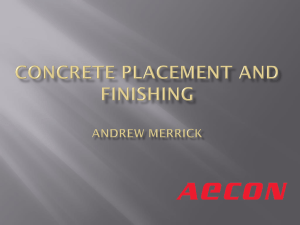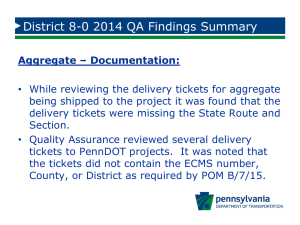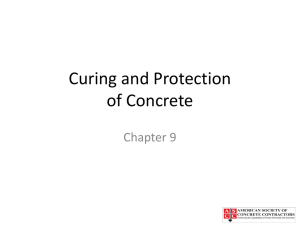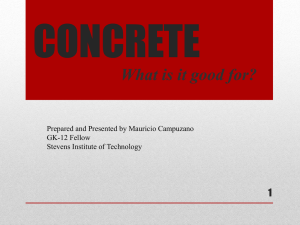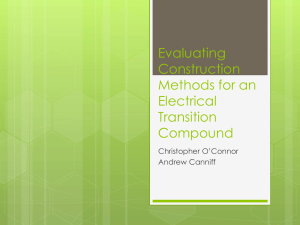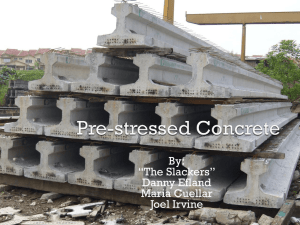6-placing quality concrete
advertisement
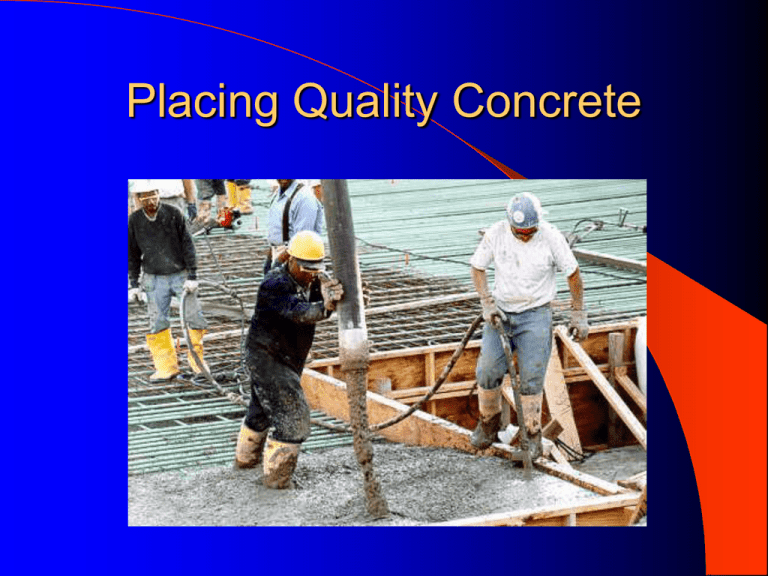
Placing Quality Concrete Control of Portland Cement Concrete Pg 134 Concrete can be designed and produced to give the desired strength under lab conditions, but under field conditions may fail. Factors which affect the quality of concrete in the field are: – Adequate support of foundations and forms – Adequate field engineering to insure conformance with plans and designs – Transportation and handling of concrete Pg 134 Factors for Placement – Weather Conditions – Methods of curing Foundations – Any concrete structure must rest upon a foundation of uniform bearing firm enough to support the entire load. Pg 135 Foundations Footings for large structures are designed according to the foundation material on which they will be placed. – For poor material in a great depth, the footing will be designed to rest on a piling. – For medium bearing quality material such as clay, a spread footing may be used to distribute the load over a larger area. Pg 135 Foundations – For good foundation material such as sound rock of sufficient depth, a smaller footing is used, and the rock will help support the load. To ensure the foundation is sound, the contractor is required to explore the foundation to a depth of at least five feet below the bottom of the footing. Pg 135 Foundations In concrete work such as pavements, curb and gutter, and paved ditches the foundation or subgrade should always be of uniform density. Before placing concrete on any foundation or subgrade, the subgrade should be moist to prevent rapid extraction of the moisture from the concrete. Pg 136 Field Engineering Concrete placed in a form may be dropped at a height of no more then five feet. Concrete forms must be constructed with enough rigidity to prevent distortion, as the concrete is being placed and cured. Reinforcing steel is used in concrete to give added strength to the concrete structure. Pg 137 Field Engineering Reinforcing steel is used for compressive and tensile strength. – Compressive strength is defined as the resistance to mashing together. Tensile strength is the resistance to pulling apart. Reinforcing steel is placed according to design and within specified tolerance to achieve maximum resistance to tension and compression. Pg 141 Placing and Finishing Concrete The first thing the inspector checks is to verify that the subgrade has been properly moistened and the forms have been oiled or moistened. When placing concrete in forms, the concrete should be placed as near to the final position as possible. Pg 144 Placing and Finishing During and immediately following placement of the concrete into the forms, care must be taken that the concrete is consolidated. – Specification requires consolidation be accomplished by mechanical vibrating internal to the concrete. – Vibration should not be used to move concrete around in forms, as this can cause segregation. Pg 152 Time, Temp, Curing The length of curing time the concrete should be protected against loss of moisture is dependent on the type of cement, mix proportions, required strength, size of the concrete mass, weather, and future exposure conditions. Pg 152 Time, Temp, Curing All material, equipment, and labor necessary to promptly apply the curing compound should be on site before any concrete is placed. A curing day will be considered as any consecutive 24 hour period beginning when the manipulation of each separate mass has been completed and during which the air temperature adajacent to the mass does not fall below 40°F. Pg 154 Plastic Shrinkage Cracks Cracking that occur on the surface of fresh concrete during setting is called plastic shrinkage cracking. Plastic shrinkage cracks appear when evaporation exceeds the rate at which bleed water rises to the surface of the concrete. When the rate of evaporation is around 0.2 pounds per square foot per hour, precautionary measures are necessary. Pg 155 Plastic Shrinkage Precautions Dampen subgrade and forms Dampen aggregates Erect windbreaks to reduce wind velocity over concrete surface Cool mixing water Protect concrete with wet coverings during any delay between placing and finishing Pg 155 Precautions Reduce time between placing and start of curing Protect concrete during the first few hours after placing to minimize evaporation Apply moisture to the surface using a fog sprayer nozzle Pg 157 Hot Weather Concreting High temperatures can accelerate the hardening of concrete and more mixing water is usually needed to get required consistency. Higher water contents mean greater shrinkage possibilities. Even concrete that is in the acceptable temperature range can have problems in hot weather. Pg 158 Hot Weather Concreting The amount of mixing water required to make a cubic yard of concrete increases as the temperature of fresh concrete increases. Increasing water content, without increasing the cement content, results in a higher water/cement ratio which will affect the strength of the concrete. The chart in figure 10 shows the effect of high concrete temp on compressive strength. Figure 10 Effects of High Temperature At high concrete temperatures the concrete gets weaker as it gets older instead of gaining strength, losing strength as the temperature of the fresh concrete increases. Pg 160 Cooling Concrete Material Crushed or flaked ice is more effective then plain water in reducing concrete. One pound of ice as it melts absorbs 144 BTU. 1 Lb of ice heated from 32°F to 73°F absorbs a total of 185 BTU. 1 Lb of water absorbs only 40 BTU when its temperature is raised from 33°F to 73°F. Cooling Concrete Material If 75 Lbs of ice per cu yd were added to a concrete mix with a temperature of 90°F the temperature of the mix would drop to 75°. During extremely hot periods it is beneficial to place the concrete in the evening or at night. Table 1000-2 Elapsed time for Placing Concrete Air or Concrete Temperature, whichever is higher 90F or above 80F through 89F 79F or below 70F through 79F 69F or below Maximum Elapsed Time No Retarding Retarding Admixture Admixture Used used 30 minutes 1 hr 15 minutes 45 minutes 1 hr 30 minutes 60 minutes 1 hr 45 minutes 60 minutes 1 hr 45 minutes 1 hr 30 minutes 2 hr 15 minutes Concrete can not be used which does not reach it’s final position in the forms within the time specified in table 1000-2.


